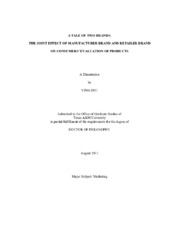| dc.description.abstract | Consumers’ purchase decisions typically involve two brands: the manufacturer brand (the “what brand to buy” decision) and the retailer brand (the “where to buy” decision). While extant research suggests that consumers’ product evaluation is affected by both, much less is known about how the two brands jointly affect consumers’ preferences. Building upon prospect theory and mental accounting principles, I hypothesize that the joint effect of the two brands on consumers’ evaluation of different products depends on the reference point evoked, and whether each of the two brands is perceived as a gain or loss relative to the reference point.
Five lab experiments provide empirical support for the hypothesized effects. Study 1 reveals that the joint effect of manufacturer and retailer brands depends on the reference product in a manner consistent with prospect theory and mental accounting principles. The results of Study 2 and 3 show that the majority of participants use a reputable brand sold at a reputable retailer as their reference product. For this group, there is a positive interaction effect of the manufacturer and retailer brands on consumers’ willingness to pay. Study 4 extends the results of Study 3 by testing the theoretical framework using a non-price measure of consumers’ product evaluation (i.e., attitude toward the offer). The results provide converging support for H1 and H2 and demonstrate the mediating role of gain and loss feelings, thus providing preliminary evidence for the proposed cognitive process. Finally, Study 5 provides supporting evidence for the predictions through the use of a priming method.
This research contributes to the literature on behavioral decision theory and branding by extending the study of mental accounting from quantitative information (e.g., money, time) to qualitative information such as that derived from brand reputation.
The findings have prescriptive implications as they can help managers understand how their brands can be leveraged, how consumers react to reference products available in the marketplace, and how to best price products across different outlets depending on the reputation of their brands and the reputation of the outlets. | en |


